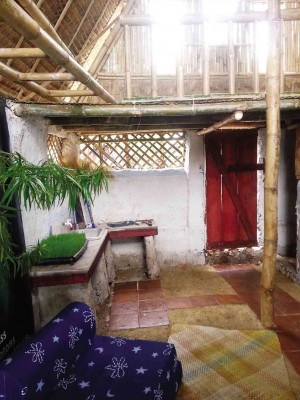A mud house goes up against the wind

A HOUSE made of mud stands out at Fisherman’s Village in Barangay Punta Engaño, Lapu-Lapu City. PHOTO by Carine Asutilla
When French-Hungarian Lehel Racz built his mud house in Lapu-Lapu City, Cebu province, it was perfect for a tropical country like the Philippines.
“You have to have a house that has a lower temperature inside, without the use of an air-conditioning unit,” said Racz, who has been visiting the country frequently for the past six years. Inside his house in Barangay Punta Engaño, the temperature is 10 degrees cooler than outside.
For two years, the 75-year-old Racz, an herbal medicine manufacturer who tours the country to relax and visit friends, had been renting a house at Fisherman’s Village in Punta Engaño whenever he was in Cebu.
But this year, an idea hit him, especially when the weather started to sizzle with the onset of summer. He would build a mud house similar to the one he had in Hungary.
Abaca fiber
When his landlord agreed to lease a 35-square-meter lot beside the house to him for P3,000 a month, Racz hired two laborers to help him put up a dwelling from mud taken from a vacant property at Fisherman’s Village.
Stones were piled up 30 inches high as foundation. The mud walls, mixed with abaca fiber as reinforcement material, are 15 inches thick and 8 feet tall.
An upper floor was added for sleeping quarters. But instead of spreading another layer of mud, Racz used bamboo stakes, which are lighter and air can easily pass through them. The floor and walls are made of bamboo as well.
The vertical extension is only about 5 feet high, just enough for a tall person like Racz to hunch over and sleep.
A wooden staircase to the upper floor is made from the trunk of a tree that fell when Supertyphoon “Yolanda” struck the province on Nov. 8, 2013.
“This house can accommodate a family with four to six members, given also that they do not have many appliances and other things because the floor area is just 35 square meters,” Racz said.
The earthen abode has front and back doors and two square windows beside each.
To conserve on space, Racz re-purposed a window pane to double as a table in the dining area.
A sink and a bathroom are found on the ground floor. Racz said he spent only P35,000 for water pipes, tiles and labor.
When the Inquirer visited Racz in his mud house, the temperature was
23 degrees Celsius compared with 33 degrees outside.
‘Refrigerator’
A mini “refrigerator,” also made of mud but with a wooden door, is attached to the wall. It keeps his drinking water cold.
Racz acknowledged that his mud house was only an experiment. He wanted to check if it could last like his mud house in Hungary.
The roof, he explained, is a big factor because it could keep the house standing amid strong typhoons and heavy rain.
“The roofing should touch the ground, so as to cover the walls made of mud. It takes years before the mud becomes tough and strong, so at first, you have to protect it with your roof,” Racz said.
None of his laborers knew how to put up the perfect roof for the mud house. Right now, the roof is made of nipa—which is lighter and cooler than the standard galvanized iron sheet—and it hardly touches the ground.
Still, Racz is willing to help anyone who wants to build their own mud house.
City Councilor Nestor Archival, an environmentalist and civil engineer, agreed that mud is cooler than the usual housing materials. “Mud is something that is alive. Something that is alive is the best. When you are alive, you are adjustable. If it’s hot, the tendency of a live form is to adopt, so inside this house, it’s cooler,” he said.
A mud house could withstand any kind of calamity, Archival said. He pointed out that Europe has mud houses shaped like eggs so these don’t go against the flow of air and thus, can withstand strong winds.















